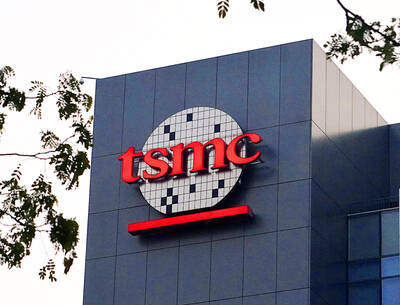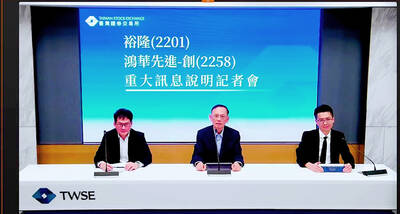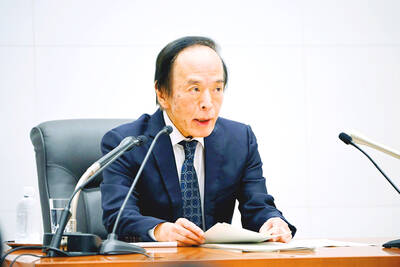Cathay Financial Holding Co (國泰金控) yesterday expressed caution about lending growth this year due to concerns over loan quality amid the COVID-19 pandemic.
Cathay United Bank (國泰世華銀行), its banking arm, is focused on retaining existing clients, but would exercise more caution in approving loans to new clients, be they local or foreign currencies, Cathay Financial spokesman Daniel Teng (鄧崇儀) said.
“It is not difficult to increase corporate loans if we want to, but it is challenging to control loan quality amid the coronavirus outbreak,” he told an investors’ conference in Taipei.
Cathay United Bank reported NT$1.519 trillion (US$50.72 billion) of lending in the first quarter, down 5 percent from a year earlier due to a 2 percent dip in mortgages and a 14 percent plunge in corporate loans, it said.
As clients turned more conservative amid the pandemic and boosted savings, the bank saw its deposits grow 7 percent annually to NT$2.38 trillion last quarter, leading its loan-to-deposit ratio to shrink to 63.9 percent, from 71.9 percent a year earlier, while its non-performing loan ratio slid from 0.18 percent to 0.15 percent.
Its net interest margin (NIM) rose from 1.23 percent at the end of last year to 1.25 percent at the end of March, which Tang attributed to falling deposit rates following central bank rate cuts in March.
However, NIM is expected to drop by 6 basis points from 1.25 percent by the end of this year, as lending rates would decrease gradually, although the bank intends to keep the gauge above 1.2 percent, Teng said.
Cathay Financial also expects its insurance unit, Cathay Life Insurance Co (國泰人壽), to see its investment return decline under a low interest rate environment.
The insurer reported a 30 percent annual drop in first-year premiums to NT$42.3 billion last quarter, as sales of traditional life insurance products worsened due to falling returns amid lower interest rates and consumers turning cautious because of the pandemic.
Cathay Life executive vice president Lin Chao-ting (林昭廷) said the insurer sold some domestic stocks in January and February and bought some stocks back in March. The firm also increased holdings of foreign stocks and domestic bonds in the first quarter, he said.
The company's financial statement indicated that Cathay Life booked gains of NT$16 billion from its equity holdings and NT$21.1 billion from its bond positions in the first quarter, up 16 percent and 273 percent from a year earlier respectively.
At the end of March, its domestic equity holdings totaled NT$372 billion, up from NT$322 billion three months earlier and accounting for 5.8 percent of total investment, while foreign stock holdings were NT$396 billion as of March 31, up from NT$370 billion a quarter ago and representing 6.2 percent of total investment, the financial statement showed.
Over the same period, domestic bond positions increased from NT$505 billion to NT$516 billion, while foreign bond holdings fell from NT$3.78 trillion to NT$3.75 trillion, data showed.
The insurer would target corporate bonds issued by companies with solid ratings and those whose yields are high enough to cover hedging costs, Lin said.
Cathay Life’s pre-hedging recurring yield declined to 3.11 percent, from 3.65 percent a quarter earlier, as it held more cash to hedge against risks in January and February, he said.
Due to the falling value of its assets, the insurer’s net value slid to NT$479.1 billion as of the end of March, from NT$594.5 billion a quarter earlier, he added.

Taiwan’s long-term economic competitiveness will hinge not only on national champions like Taiwan Semiconductor Manufacturing Co. (TSMC, 台積電) but also on the widespread adoption of artificial intelligence (AI) and other emerging technologies, a US-based scholar has said. At a lecture in Taipei on Tuesday, Jeffrey Ding, assistant professor of political science at the George Washington University and author of "Technology and the Rise of Great Powers," argued that historical experience shows that general-purpose technologies (GPTs) — such as electricity, computers and now AI — shape long-term economic advantages through their diffusion across the broader economy. "What really matters is not who pioneers

In a high-security Shenzhen laboratory, Chinese scientists have built what Washington has spent years trying to prevent: a prototype of a machine capable of producing the cutting-edge semiconductor chips that power artificial intelligence (AI), smartphones and weapons central to Western military dominance, Reuters has learned. Completed early this year and undergoing testing, the prototype fills nearly an entire factory floor. It was built by a team of former engineers from Dutch semiconductor giant ASML who reverse-engineered the company’s extreme ultraviolet lithography (EUV) machines, according to two people with knowledge of the project. EUV machines sit at the heart of a technological Cold

TAIWAN VALUE CHAIN: Foxtron is to fully own Luxgen following the transaction and it plans to launch a new electric model, the Foxtron Bria, in Taiwan next year Yulon Motor Co (裕隆汽車) yesterday said that its board of directors approved the disposal of its electric vehicle (EV) unit, Luxgen Motor Co (納智捷汽車), to Foxtron Vehicle Technologies Co (鴻華先進) for NT$787.6 million (US$24.98 million). Foxtron, a half-half joint venture between Yulon affiliate Hua-Chuang Automobile Information Technical Center Co (華創車電) and Hon Hai Precision Industry Co (鴻海精密), expects to wrap up the deal in the first quarter of next year. Foxtron would fully own Luxgen following the transaction, including five car distributing companies, outlets and all employees. The deal is subject to the approval of the Fair Trade Commission, Foxtron said. “Foxtron will be

INFLATION CONSIDERATION: The BOJ governor said that it would ‘keep making appropriate decisions’ and would adjust depending on the economy and prices The Bank of Japan (BOJ) yesterday raised its benchmark interest rate to the highest in 30 years and said more increases are in the pipeline if conditions allow, in a sign of growing conviction that it can attain the stable inflation target it has pursued for more than a decade. Bank of Japan Governor Kazuo Ueda’s policy board increased the rate by 0.2 percentage points to 0.75 percent, in a unanimous decision, the bank said in a statement. The central bank cited the rising likelihood of its economic outlook being realized. The rate change was expected by all 50 economists surveyed by Bloomberg. The